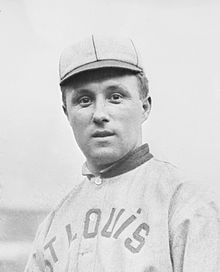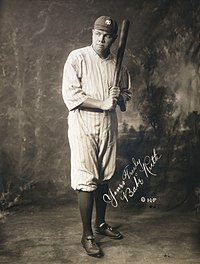Paul Krichell
| Paul Krichell | |
|---|---|
 Paul Krichell during the 1911 season | |
| Catcher | |
| Born: December 19, 1882 Paris, France | |
| Died: June 4, 1957 (aged 74) New York City, U.S. | |
Batted: Right Threw: Right | |
| MLB debut | |
| May 12, 1911, for the St. Louis Browns | |
| Last MLB appearance | |
| September 22, 1912, for the St. Louis Browns | |
| MLB statistics | |
| Batting average | .222 |
| Home runs | 0 |
| RBIs | 16 |
| Teams | |
| Career highlights and awards | |
| |
Paul Bernard Krichell (December 19, 1882 – June 4, 1957) was a French Major League Baseball catcher, best known for being the head scout for the New York Yankees for 37 years until his death. Krichell's talent evaluations and signings played a key role in building up the Yankees' run of success from the Murderers' Row teams of the 1920s to the 1950s teams led by Casey Stengel.[2]
Krichell began his professional career in the minor leagues, playing as the reserve catcher for the
Early life
Krichell was born in
Playing and managing career
After the 1912 season, the Browns released Krichell, but after recovering from his injury, he played six seasons in the minor leagues. He was the starting catcher for the
Scouting career

Prior to the 1921 season, Barrow was appointed
Discovery of Gehrig
Early in the 1923 season, while traveling to New Brunswick, New Jersey, for a baseball game between Columbia University and Rutgers University,[17] Krichell shared a train with the manager of the Columbia squad, Andy Coakley.[18] They discussed Lou Gehrig, a left-handed pitcher on his squad who could also hit,[1][18] and later that day, Gehrig hit two home runs in three at-bats.[18] Following the game, Krichell spoke with Barrow, saying he had found the "next Babe Ruth".[19] Skeptical, Barrow sent Krichell to watch Columbia's next game against New York University,[18] where Gehrig hit a home run that reportedly went out of the stadium.[20] After the game, Krichell persuaded Gehrig to sign for the Yankees for $2,000 ($30,000 in 2010) for the remainder of 1923, with a $1,500 bonus ($20,000 in 2010).[19] Krichell also asked Gehrig to give up pitching to focus on being a hitter.[21]
After joining up with the team for batting practice in June 1923, Gehrig was sent by Yankees manager Miller Huggins to the Hartford Senators. After a good start, Gehrig went through a long slump and suffered depression which led him to consider quitting baseball.[22] Upon hearing this, Krichell was sent to Hartford to speak with the star player. He discovered that Gehrig was drinking, boosted his confidence and gave him batting advice, including one of Ty Cobb's batting tricks.[23] Gehrig started hitting again, and eventually joined the Yankees.
Later signings
1920s

Before the 1925 New York Yankees season, Babe Ruth collapsed at a train station in Asheville, North Carolina. Krichell's actions may have saved Ruth's life. On the instructions of Huggins, Krichell drove Ruth to hospital,[24] before traveling with Ruth by train to New York, where Ruth had emergency surgery for an "intestinal abscess" that left him hospitalized for six weeks.[25]
The same year, Krichell went to Hartford, Connecticut, to sign shortstop Leo Durocher for a $7,500 bonus ($90,000 in 2010).[26] When the deal was concluded, Barrow sent Krichell to Salt Lake City to watch young second baseman Tony Lazzeri, who played for the Salt Lake Bees of the Pacific Coast League and hit 60 home runs and achieved over 200 RBIs the previous season.[27] The Bees were asking for $50,000 ($620,000 in 2010), but several scouts placed his value ten times lower.[3] The Chicago Cubs were given the option to sign him for a discounted rate, but declined because he had epilepsy.[3][28] Krichell saw promise in the player and convinced Barrow to buy him.[3] Around the same time, he helped acquire shortstop Mark Koenig from the Minneapolis Millers.[29] These Krichell signings formed part of the 1927 New York Yankees team, considered by many to be the greatest team ever assembled.[30] Four of the starters in this squad were signed by Krichell, including three-quarters of its infield and Mike Gazella, its main backup, who signed for $500 in 1923 ($10,000 in 2010).[31] The Yankees took just four games to defeat the Pittsburgh Pirates and win the 1927 World Series.[32]
To assist at practice for the
In the summer of 1929, Krichell discovered Hank Greenberg while on a scouting trip in Massachusetts. Krichell believed Greenberg would be the next Lou Gehrig.[34] Krichell offered Greenberg a $10,000 contract ($130,000 in 2010) on the spot based on his potential and knowing the Yankees were looking for Jewish players to increase their Jewish fanbase.[34] Greenberg discussed the deal with his father but declined it because he knew his opportunities would be limited by the presence of Gehrig as first baseman.[35] Subsequently, he signed with the Detroit Tigers.
1930s
In the early 1930s, Krichell focused on
Aside from his Ivy League pitcher focus, Krichell also unearthed several position players. He signed
1940s–1950s
Krichell's next target was
Krichell played a factor in signing future All-Star Tommy Byrne.[45] He was referred by one of his scouts, Gene McCann, to see Byrne pitch for Wake Forest University.[45] Impressed with what he saw, Krichell signed him for $10,000 ($160,000 in 2010).[46] He also signed Red Rolfe and Vic Raschi.[1] Krichell oversaw the expansion of the New York Yankees scouting staff from two men to more than twenty part-time scouts by 1957.[1] Among the scouts he hired for the Yankees were former players Babe Herman, Atley Donald, Jake Flowers and Johnny Neun.[47] As he hired more scouts, Krichell reduced his own role, becoming the chief scout and regional scout for the New England area.[47]

In 1948, Krichell was involved in a minor scandal. Harry Nicolas was a high school baseball star in
Final days
In 1954, Krichell was honored by the
Krichell died on June 4, 1957, at his home in the
Scouting style
When he first started his scouting career, Krichell followed the example of early baseball scouts. He traveled with the Yankees for spring training to view his signees playing baseball. When the Yankees traveled north to begin their season, Krichell usually followed.[17] He also scouted the local newspapers to look for games in which potential prospects were playing.[18]
Later, his style of scouting was used as a blueprint by scouts to evaluate players. He usually ignored the obvious tools such as
At other times, Krichell collected some of the best
Legacy
Krichell is considered one of the greatest scouts in baseball history.
Notes
- ^ a b c d e f g h i j k l "Paul. B. Krichell of Yankees dies". The New York Times. June 5, 1957. Retrieved February 4, 2010. (subscription required)
- ^ James (1995), p. 217
- ^ a b c d e f g h i j k l m n o p q r s t u Caremer, Dave (July 1957). "36 Years as a Yankee". Baseball Digest. pp. 27–39. Retrieved February 4, 2009.
- ^ a b Gallagher, p. 343
- ^ a b Levitt, p. 75
- ^ "Paul Krichell Minor League Statistics & History". Baseball-Reference.com. Retrieved 2010-05-25.
- ^ a b c "Paul Krichell". Baseball-Reference.com. Retrieved February 4, 2009.
- ^ "1912 St. Louis Browns". Baseball-Reference.com. Retrieved September 12, 2010.
- ^ Eig, p. 38-40
- ^ a b c J. G. Taylor Spink (April 20, 1939). "Criss Crossing Talent Trails With Krichell". The Sporting News. p. 8.
- ^ a b Levitt, p. 188
- ^ "Yanks's Lose in 9th, Fall Back on Race". Hartford Courant. June 18, 1918. p. 10.
- ^ a b Meany, Thomas (1951). Baseball's greatest pitchers. A.S. Barnes. p. 101.
- ISBN 978-0-471-77812-7.
- ^ Eig, p. 66
- ^ Eig, p. 67
- ^ a b Eig, p. 38
- ^ a b c d e Eig, p. 39
- ^ a b Frommer, p. 44
- ^ Eig, p. 40
- ^ Maisel, Ivan (April 12, 1982). "Scouts Stay Persona Non Grata To Baseball's Hall Of Fame Committee". Sports Illustrated. Retrieved February 4, 2010.
- ^ Eig, pp. 41, 44, 48
- ^ Eig, p. 49
- ISBN 978-0-385-51437-8.
- ^ Spector, Jessie (June 19, 2005). "Touching Base. Close Calls. One-run games make big difference to even best teams". New York Daily News.
- ISBN 978-0-8032-2453-7.
- ^ Frommer, p. 49
- ISBN 0-393-04894-2.
- ^ Gallagher, p. 123
- ^ Gallagher, p. 5
- ^ Frommer, p. 56
- ^ "1927 World Series – New York Yankees Over Pittsburgh Pirates (4–0)". Baseball-Reference.com. Retrieved 2010-05-08.
- ^ Cranston, Mike (June 14, 2008). "Oldest living ex-major leaguer has stories to tell". USA Today. Retrieved February 4, 2010.
- ^ a b Eig, p. 133
- ^ Eig, p. 134
- ^ Gallagher, p. 38
- ISBN 0-446-69269-7.
- ^ a b Madden, p. 27
- ^ Daniel M. Daniel (September 16, 1937). "Grandma Murphy Patches Up Yankee Pitching Staff". The Sporting News. p. 3.
- ISBN 0-8032-6359-7.
- ^ Gallagher, p. 342
- ^ Madden, p. 4
- ^ Dexter, Charles (January 1948). "Bronx Express:Snuffy Stirnweiss". Baseball Digest. p. 4. Retrieved February 9, 2009.
- ISBN 978-0-7573-0626-6.
- ^ a b Staples, p. 45
- ^ Staples, p. 46
- ^ a b Shaplen, Robert (September 20, 1954). "New York Yankee Organization". Sports Illustrated. Retrieved February 4, 2010.
- ^ Jack Lang (January 28, 1948). "Harry Nicolas to Decide on Graduation January 30". The Sporting News. p. 3.
- ^ Gallagher, p. 250
- ^ Voigt, p. 177
- ^ Berger, p. 99
- ^ Graham, p. 141
- ^ Madden, p. 5
- ^ Tranchtenburg, p. 175
- ^ a b Feldman, Jay (February 5, 1990). "Make Scouts Eligible For Cooperstown". Sports Illustrated. Retrieved February 4, 2010.
- ^ Kuenster, John (December 1992). "Scouts and Coaches Should Be Eligible for the Hall of Fame". Baseball Digest. p. 17.
- ^ James (2003), p. 256
Bibliography
- Berger, Lance A.; Dorothy R. Berger (2005). Management Wisdom from the New York Yankees' Dynasty. Wiley Publishers. ISBN 0-471-71554-9.
- Blackwell, Peter (1983). American Baseball: From the Commissioners to Continental Expansion, Volume 3. Penn State University Press. ISBN 0-271-00330-8.
- Eig, Jonathan (2005). Luckiest man: the Life and Death of Lou Gehrig. Simon & Schuster. ISBN 0-7432-4591-1.
- Gallagher, Mark (2003). The Yankee Encyclopedia. Sports Publishing L.L.C. ISBN 1-58261-683-3.
- Graham, Frank (2003). A Farewell to Heroes. Southern Illinois University Press. ISBN 0-8093-2491-1.
- James, Bill (2003). The New Bill James Historical Baseball Abstract. Simon & Schuster. p. 256. ISBN 0-684-80697-5.
- ISBN 0-684-80088-8.
- Levitt, Daniel R. (2008). Ed Barrow: The Bulldog Who Built the Yankees' First Dynasty. University of Nebraska Press. ISBN 978-0-8032-2974-7.
- Trachtenberg, Leo (1995). The Wonder Team: The True Story of the Incomparable 1927 New York Yankees. Popular Press. ISBN 0-87972-677-6.
External links
- Career statistics and player information from Baseball Reference, or Fangraphs, or Baseball Reference (Minors)
